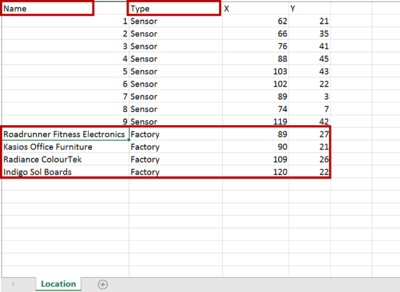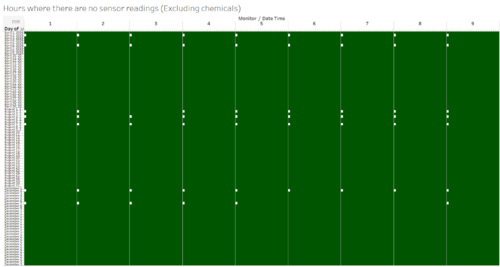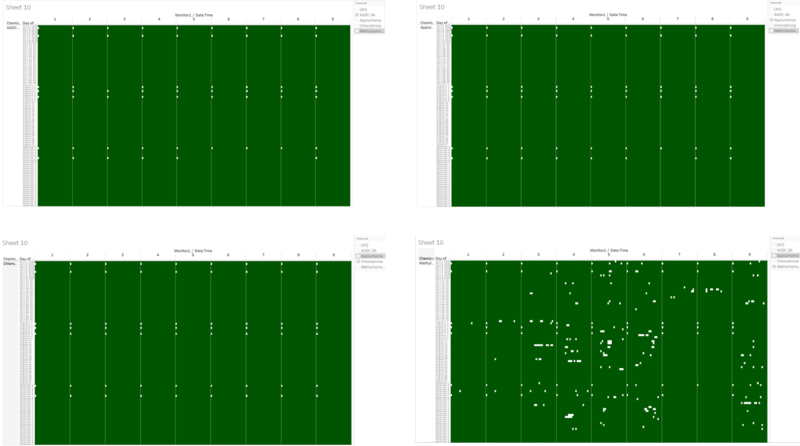IS428 2017-18 T1 Assign Lucas Leong Li Heng
Contents
Links
The Task
General Task
The four factories in the industrial area are subjected to higher-than-usual environmental assessment, due to their proximity to both the city and the preserve. Gaseous effluent data from several sampling stations has been collected over several months, along with meteorological data (wind speed and direction), that could help Mitch understand what impact these factories may be having on the Rose-Crested Blue Pipit. These factories are supposed to be quite compliant with recent years’ environmental regulations, but Mitch has his doubts that the actual data has been closely reviewed. Could visual analytics help him understand the real situation?
The primary job for Mitch is to determine which (if any) of the factories may be contributing to the problems of the Rose-crested Blue Pipit. Often, air sampling analysis deals with a single chemical being emitted by a single factory. In this case, though, there are four factories, potentially each emitting four chemicals, being monitored by nine different sensors. Further, some chemicals being emitted are more hazardous than others. Your task, as supported by visual analytics that you apply, is to detangle the data to help Mitch determine where problems may be. Use visual analytics to analyze the available data and develop responses to the questions below.
The Specific Tasks
- Characterize the sensors’ performance and operation. Are they all working properly at all times? Can you detect any unexpected behaviors of the sensors through analyzing the readings they capture?Limit your response to no more than 9 images and 1000 words.
- Now turn your attention to the chemicals themselves. Which chemicals are being detected by the sensor group? What patterns of chemical releases do you see, as being reported in the data? Limit your response to no more than 6 images and 500 words.
- Which factories are responsible for which chemical releases? Carefully describe how you determined this using all the data you have available. For the factories you identified, describe any observed patterns of operation revealed in the data. Limit your response to no more than 8 images and 1000 words.
Data Preparation
Location Data
The location of the factories is not stored within any of the data sheets given. We will append the coordinates of the factories locations into the file "Sensor Location". A new column is added called "Type" which classifies the records into either "Sensor" or "Factory. The column name "Monitor" is changed to "Name". The output is as shown below.
Meteorological Data
In this file, there is a column called "Elevation". We will remove it since it does not contribute to the visualisation process. In row 445, at time 8/30/16 3:00, Wind Direction and Wind Speed values are missing. A value of 0 is assumed and added into the row. In row 460, there is a blank row. This entire row is removed to facilitate the data import process into Tableau.
Task 1
Firstly, we will explore the sensor performance and operation, and check for unexpected behaviour. We will check for missing sensor readings, and construct highlight tables to visualize these missing readings.
Hours with missing sensor readings (Excluding Chemicals)
Firstly, we will find out if there are times when the sensor stops working, without introducing chemicals yet to get an overall high level view. In figure 3 below, dates/hours which have at least one record are coloured in dark green, while dates/hours without any record are white. These white boxes represent the date/hour where there are no sensor readings.
Figure 3 shows an interesting pattern, where the timings at which there are no sensor readings are all at 12AM. The specific dates are 2 April, 6 April, 2 August, 4 August, 7 August, 2 December and 7 December. Possible reasons might be scheduled maintenance for the censors.
Adding chemicals into visualization
Next, we will dive deeper into sensor performance by adding chemicals into the visualisation. The respective highlight chart for each chemical is shown below.
- At first look, it is obvious that Methylosmolene has a lot more missing sensor reading compared to the other 3 chemicals. We will explore these missing sensor readings later on.
- For AGOC-3A, there are no additional missing sensor readings to those already revealed in figure 3.
- For Appluimonia, there are 3 additional missing sensor readings compared to figure 3. These are for sensor 3 on 2nd August, and sensor 6 and 8 on 7th December. All of these missing sensor readings are at 12 AM.
- For Chlorodinine, there are 4 additional missing sensor readings compared to figure 3. These are sensor 3 reading on 2nd August, and sensor 6,7, and 8 readings on 7th December. All of these missing sensor readings are at 12 Am.
Exploring missing readings of Methylosmolene
Now we will attempt to explore the missing readings for Methylosmolene. To do that, we will edit the colours so that different colours represent the different number of records. Red will be used to represent hours containing 2 records, while green represents hours with 1 record.
There are no changes to Appluimonia, Chlorodinine and Methylosmolene. However, an interesting pattern appears in AGOC-3A. When compared with Methylosmolene, it can be seen that hours with 2 records in AGOC-3A fits in perfectly into Methylosmolene. This might mean that the readings for Methylosmolene were intentionally classified as AGOC-3A in order to reduce the total levels of Methylosmolene recorded.




